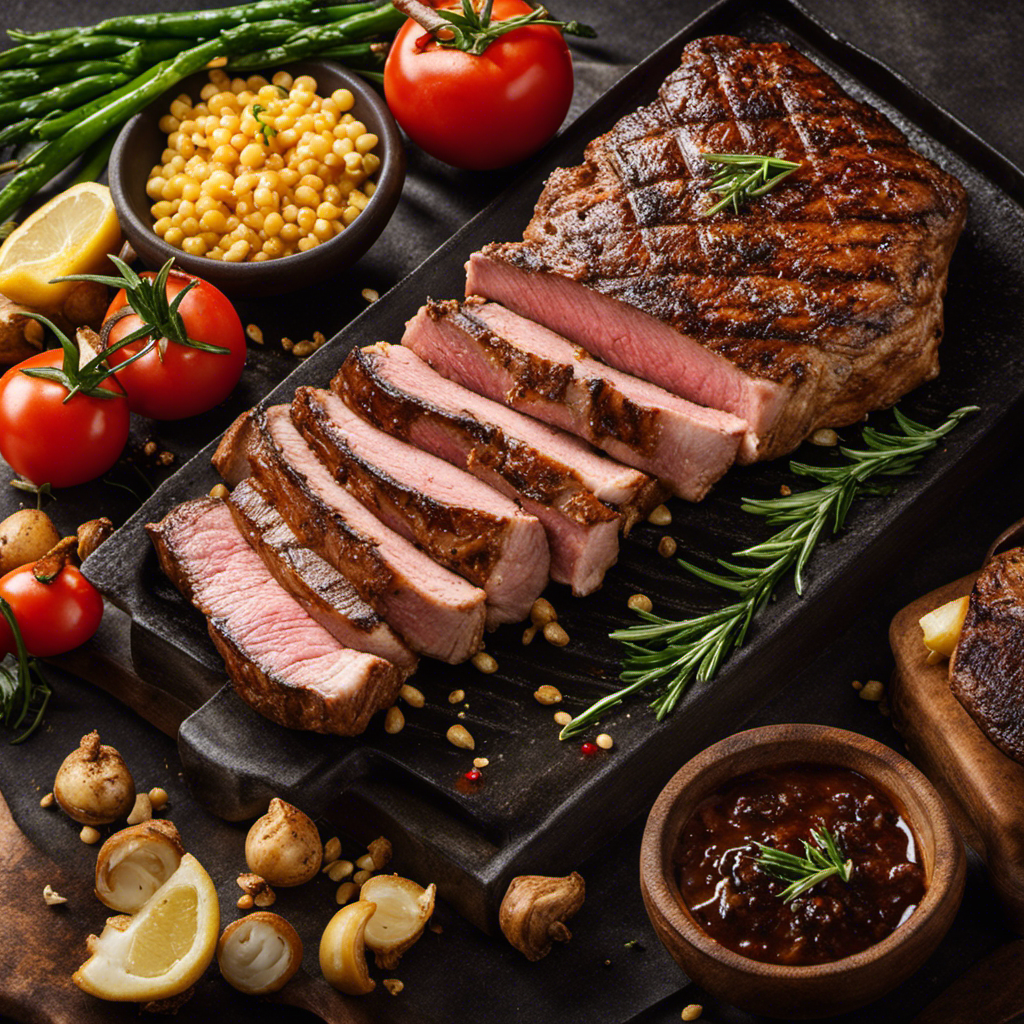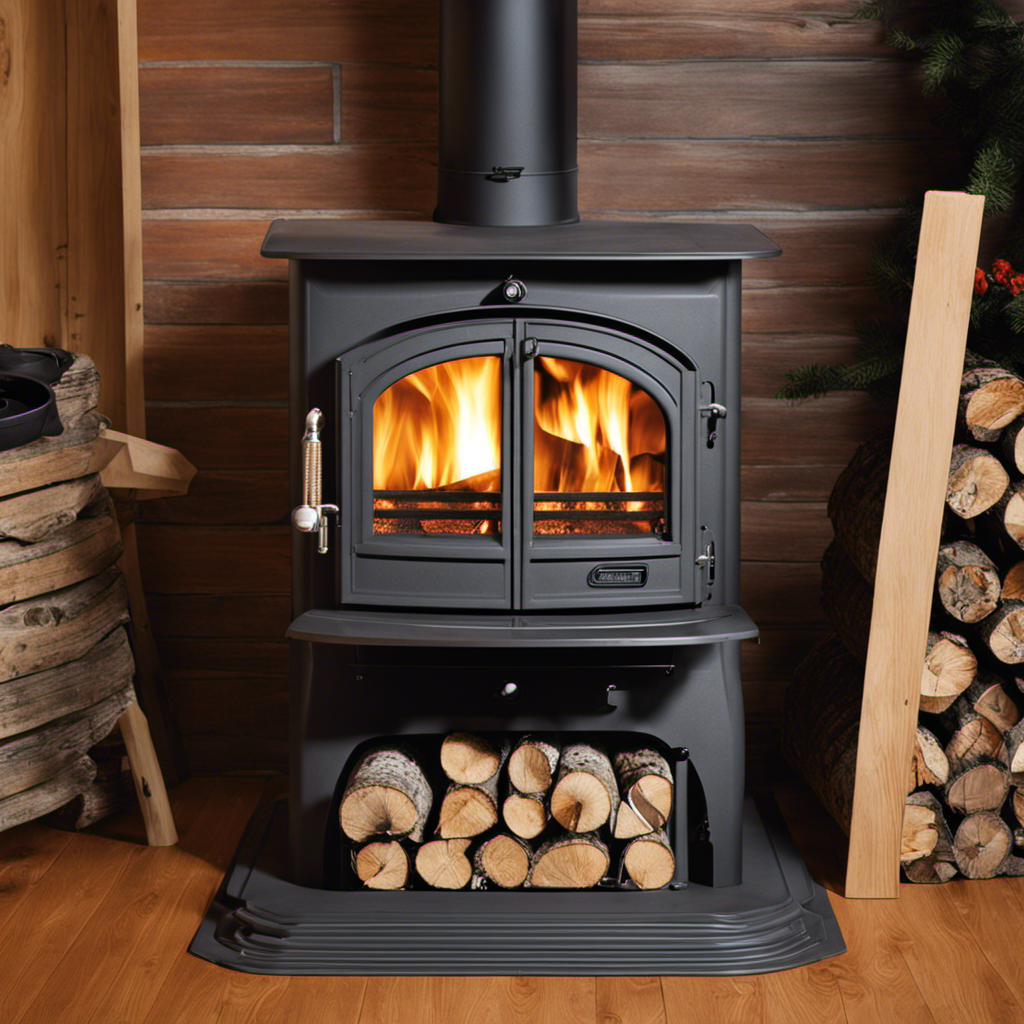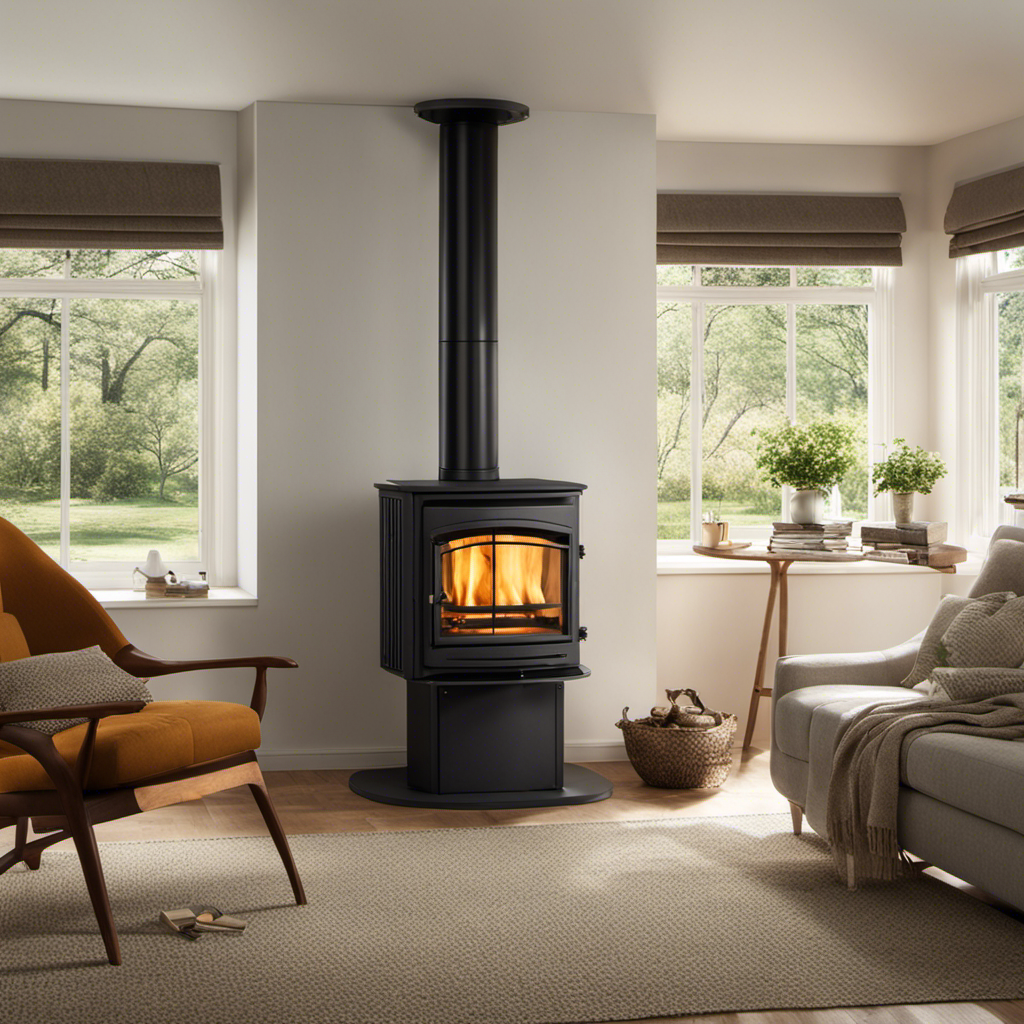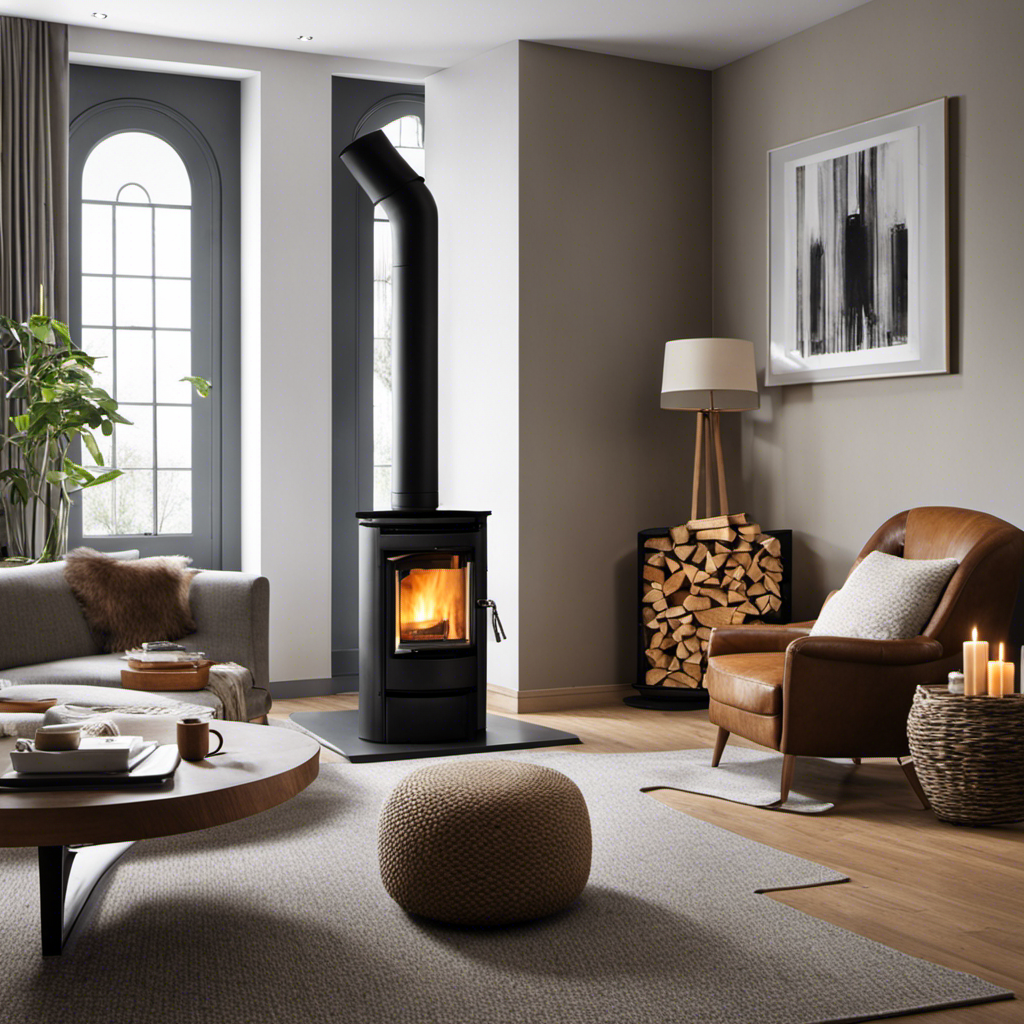I’ve always valued the rich, woody taste of pork steaks when they are cooked on a wood pellet grill. The method by which the smoke permeates the meat enhances a flavorful and hearty taste that is genuinely outstanding.
In this article, I will guide you through the process of selecting the perfect pork steaks, preparing the wood pellet smoker, seasoning the meat, and monitoring the cooking process. By the end, you’ll be able to serve up a mouthwatering dish that will have everyone asking for seconds.
So, let’s get started and unlock the secrets to cooking pork steaks on a wood pellet smoker.
Key Takeaways
- Choose well-marbled cuts with a good amount of fat for added flavor.
- Experiment with different cooking techniques like grilling, pan-frying, or oven-baking.
- Use marinades or dry rubs to enhance the flavor and tenderness of the pork steaks.
- Monitor the internal temperature using a meat thermometer and aim for an internal temperature of 145°F (63°C) for perfectly cooked pork steaks.
Selecting the Perfect Pork Steaks
When selecting the perfect pork steaks, it’s important to choose cuts that are well-marbled and have a good amount of fat for added flavor. The marbling in the meat ensures that it stays juicy and tender during the cooking process.
Look for pork steaks that have a nice layer of fat on the outside, as this will help to enhance the taste and texture of the meat.
When it comes to cooking techniques, pork steaks can be grilled, pan-fried, or even oven-baked. Each method offers a unique flavor profile and texture, so it’s important to choose the one that suits your taste preferences.
As for marinating options, you can use a variety of ingredients such as soy sauce, garlic, herbs, and spices to infuse the pork steaks with delicious flavors.
Now, let’s move on to preparing the wood pellet smoker for the perfect cooking experience.
Preparing the Wood Pellet Smoker
To get started, you’ll need to prep the wood pellet smoker. This is an essential step to ensure that your pork steaks come out perfectly cooked and full of flavor. Here’s what you need to do:
- Clean the wood pellet smoker thoroughly before use to remove any residue from previous cooks.
- Empty and clean the ash pan to prevent any unwanted flavors from affecting your pork steaks.
- Check and clean the temperature probe to ensure accurate temperature readings throughout the cooking process.
- Maintain temperature control by ensuring that the pellet hopper is filled with high-quality wood pellets.
- Adjust the temperature settings according to your recipe’s requirements and keep a close eye on the temperature throughout the cooking process.
Now that the wood pellet smoker is prepped and ready, it’s time to move on to seasoning the pork steaks.
Seasoning the Pork Steaks
Once you’ve prepped the wood pellet smoker, it’s time to season the pork steaks for maximum flavor.
Marinating techniques can really take your pork steaks to the next level, infusing them with delicious flavors and ensuring they stay juicy and tender. One of my favorite marinades is a combination of soy sauce, garlic, brown sugar, and Worcestershire sauce. Simply mix these ingredients together, place the pork steaks in a ziplock bag, and let them marinate in the refrigerator for at least 2 hours, or preferably overnight.
If you’re looking for alternative seasoning options, try a dry rub made with paprika, brown sugar, salt, pepper, and your favorite spices. This will add a nice crust and flavor to the pork steaks when they’re cooked.
Now that the pork steaks are seasoned to perfection, let’s move on to smoking them to achieve that smoky, melt-in-your-mouth goodness.
Smoking the Pork Steaks
When it comes to smoking pork steaks, two key factors to consider are the optimal smoking time and the recommended wood pellet to use.
The optimal smoking time will ensure that the pork steaks are cooked to perfection, with a tender and juicy texture.
As for the wood pellet, choosing the right one will enhance the flavor profile of the pork steaks, adding a delicious smoky taste that complements the meat.
Optimal Smoking Time?
The optimal smoking time for pork steaks on a wood pellet grill is typically around two hours. This allows enough time for the smoke to infuse into the meat, resulting in a deliciously smoky flavor. Achieving the perfect smoke intensity and temperature control is crucial for a successful smoke session. Here are three key factors to consider:
-
Smoke intensity: Controlling the amount of smoke is essential to prevent overpowering the delicate flavors of the pork steaks. Adjust the vents on your grill to regulate the airflow, ensuring a steady stream of smoke without it becoming too thick.
-
Temperature control: Maintaining a consistent temperature is vital for evenly cooked pork steaks. Use a digital thermometer to monitor the temperature inside the grill, adjusting the settings as needed to stay within the desired range.
-
Wood pellet selection: The type of wood pellets you choose will impact the flavor profile of your pork steaks. Experiment with different varieties like hickory, apple, or mesquite to find the perfect match for your taste preferences.
Now that we have discussed the optimal smoking time and factors for smoke intensity and temperature control, let’s move on to the next section: ‘Which wood pellet is recommended for pork steaks?’
Recommended Wood Pellet?
To achieve the best flavor for your pork steaks, consider trying out different types of wood pellets, such as hickory or apple. When it comes to choosing the best wood pellet brands, there are a few factors to consider.
Hickory wood pellets are known for their strong, smoky flavor, which pairs well with pork. On the other hand, apple wood pellets impart a milder, slightly sweet taste to the meat. Both options have their own pros and cons.
While hickory provides a bold flavor, it might be too intense for some palates. Apple wood, on the other hand, may not give you that strong smoky taste you’re looking for. Ultimately, it’s a matter of personal preference.
Now that we have the perfect wood pellets, let’s move on to monitoring the cooking process.
Monitoring the Cooking Process
Keep an eye on the internal temperature of your pork steaks while they cook on the wood pellet grill. This is crucial to ensure that your pork steaks are cooked to perfection and safe to eat.
To measure the internal temperature, I highly recommend using a meat thermometer. Insert the thermometer into the thickest part of the pork steak, making sure not to touch the bone. The ideal internal temperature for pork steaks is 145°F (63°C). This will give you juicy and tender pork that is cooked just right.
Once the pork steaks reach the desired temperature, remove them from the grill and let them rest for a few minutes before serving. This allows the juices to redistribute, resulting in a more flavorful and succulent bite.
Now, let’s move on to the next section where we’ll discuss serving and enjoying the delicious pork steaks.
Serving and Enjoying the Pork Steaks
When it comes to serving and enjoying pork steaks, there are two key points to consider: the best side dishes and grilling tips and tricks.
As an experienced griller, I can confidently say that the right side dish can elevate the flavors of the pork steaks. Whether it’s a refreshing coleslaw, grilled vegetables, or creamy mashed potatoes, the perfect accompaniment can enhance the overall dining experience.
Additionally, mastering grilling techniques is crucial for achieving tender and flavorful pork steaks that will impress your guests. Proper temperature control, marinating the meat, and using the right seasoning are all essential factors in creating a delicious end result.
Best Side Dishes?
Looking for some tasty side dishes to complement your pork steaks? Well, look no further! When it comes to pairing pork steaks, there are two classic options that are sure to please your taste buds.
First, grilled vegetables are a fantastic choice. The smoky flavor from the grill perfectly complements the juicy pork and adds a healthy touch to your meal. Simply toss some bell peppers, zucchini, and mushrooms in olive oil, sprinkle with salt and pepper, and grill until tender.
Second, you can never go wrong with creamy mashed potatoes. Their velvety texture and rich flavor make them the perfect accompaniment to pork steaks. Whip up a batch of mashed potatoes with butter, milk, and a hint of garlic for a truly indulgent side dish.
Now that you have the perfect sides, let’s move on to some grilling tips and tricks.
Grilling Tips and Tricks
Now that we have covered the best side dishes, let’s dive into some grilling tips and tricks. When it comes to grilling, proper grill maintenance and temperature control are key to achieving delicious and perfectly cooked pork steaks. Here are some expert tips to help you elevate your grilling game:
| Grill Maintenance | Temperature Control |
|---|---|
| Clean the grill grates | Preheat the grill properly |
| Check for gas leaks | Use a thermometer |
| Oil the grates | Create heat zones |
Maintaining your grill is essential for safety and optimal cooking. Regularly clean the grill grates and check for gas leaks to ensure a smooth grilling experience. When it comes to temperature control, preheating your grill properly is crucial. Use a thermometer to monitor the temperature and create heat zones for different cooking requirements. By following these grilling tips and tricks, you’ll be able to achieve mouthwatering pork steaks every time. Happy grilling!
Frequently Asked Questions
Can I Use a Gas or Charcoal Grill Instead of a Wood Pellet Smoker to Cook Pork Steaks?
Yes, you can use a gas or charcoal grill instead of a wood pellet smoker to cook pork steaks. Both methods offer different flavors and require different techniques for seasoning.
How Long Does It Take to Season the Pork Steaks Before Smoking Them?
To season the pork steaks before smoking, I recommend using a combination of salt, pepper, garlic powder, and paprika. Let them sit in the seasoning for at least 1 hour. This will enhance the flavor and tenderness.
Can I Use a Dry Rub Instead of a Marinade to Season the Pork Steaks?
Yes, you can use a dry rub instead of a marinade to season pork steaks. A popular dry rub for pork steaks includes a mix of paprika, brown sugar, garlic powder, salt, and pepper. It adds great flavor when grilled or smoked.
How Often Should I Check the Temperature of the Wood Pellet Smoker While Cooking the Pork Steaks?
When cooking pork steaks on a wood pellet smoker, it’s important to check the temperature regularly to ensure they cook evenly and reach the desired doneness. I recommend checking every 30 minutes or so.
Can I Use Fruitwood Pellets Instead of Hardwood Pellets for Smoking the Pork Steaks?
Yes, you can use fruitwood pellets for smoking pork steaks. Fruitwood pellets offer different flavor profiles compared to hardwood pellets, adding a unique and delicious taste to your cooked meat.
Conclusion
In conclusion, cooking pork steaks on a wood pellet smoker is an art that can result in a mouthwatering and flavorful meal. By carefully selecting the perfect pork steaks, preparing the smoker, and seasoning the meat, you can ensure a delicious outcome.
Just like a master painter meticulously selects their colors and brushes to create a stunning masterpiece, the process of cooking pork steaks requires attention to detail and a deep understanding of flavors.
So, grab your wood pellet smoker and let your culinary creativity shine through as you create a culinary masterpiece that will leave everyone wanting more.
Logan’s affair with adventure began in childhood. He hailed from a small town where vast forests bordered one side and endless shores stretched on the other. His days were spent exploring uncharted woods, climbing tall trees, or listening to the tales of old sailors. This early immersion in a world brimming with stories and mysteries became the foundation of his passion for writing.











